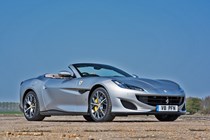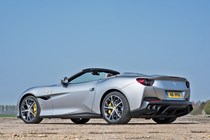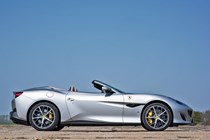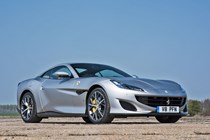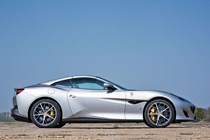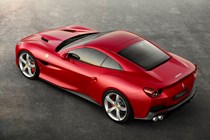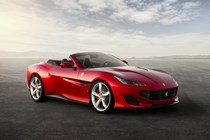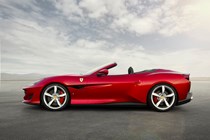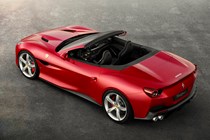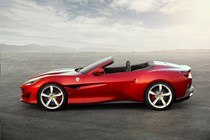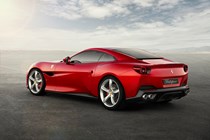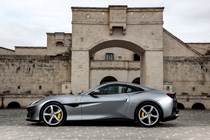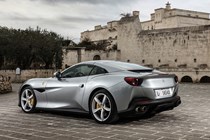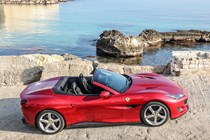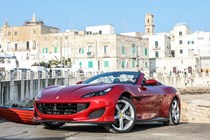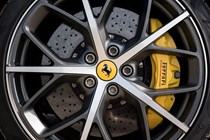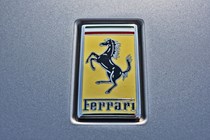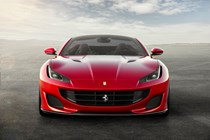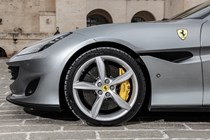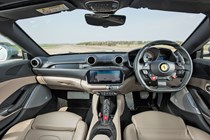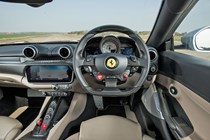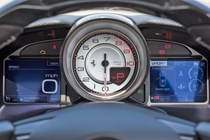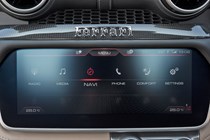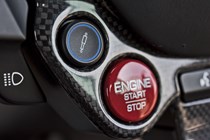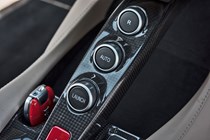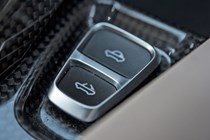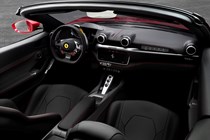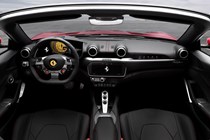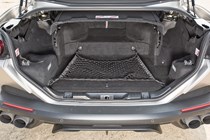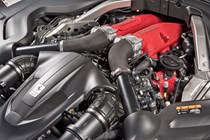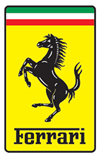
Ferrari Portofino Convertible engines, drive and performance
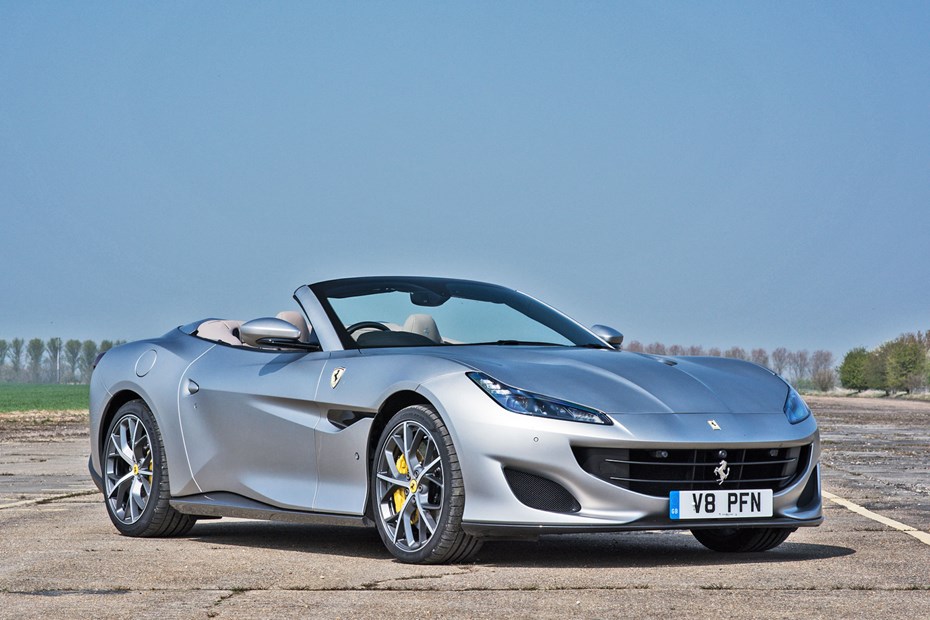
- Powerful turbocharged V8 engine
- Smooth and quick twin-clutch gearbox
- Sport and Comfort drive modes
As you’d expect from any Ferrari, one of the Portofino’s highlights is its performance. The engine is basically the same turbocharged 3.9-litre petrol V8 that was in the California T, but the firm’s engineers changed several components and in the process boosted output by 40hp for a nice round 600hp.
This is backed up by a considerable maximum torque output of 760Nm available between 3,000 and 5,250rpm in seventh gear. In lower gears torque is limited to ensure optimum traction.
All that punch is fed through a seven-speed twin-clutch gearbox that by default works in Automatic mode, but the driver is able to manually control shifts at any time via large paddles on the steering column.
How fast is the Ferrari Portofino?
In a word: very.
It isn’t quite in the same performance ballpark as the more focused supercars in Ferrari’s line-up – such as the 488, 812 Superfast and LaFerrari – but with a 0-62mph time of 3.5 seconds, 0-124mph in 10.8 seconds and a top speed of ‘more than’ 199mph, it’ll easily outrun the majority of cars on the road. That’s quite something for a car that’s billed as the ‘Everyday Ferrari’.
But it’s the way this power is delivered that makes the Portofino feel like a true Ferrari. For a start, the engine note sounds more aggressive than you might expect of a car that’s supposed to be more of an exotic grand tourer, and while driving normally requires more of a prod of the accelerator than you might expect, once you get going the Portofino can be just as ferocious as it can be relaxed.
You’ll be disappointed if you’ve ever driven a non-turbo Ferrari though; the turbocharger, vital to lower emissions and improve fuel economy in this modern world, makes it impossible for the engine to really sing like the older 458 – which has an engine that is among our reviewing team’s favourite-sounding of all time.
However, the fact that the motor revs all the way to 7,500rpm also helps driveability, with the noise and associated thrust increasing all the way to the redline.
We were able to discern noticeable extra flexibility in this engine compared with its performance in the older California T – Ferrari claims 5% more performance over the rev range and we have no reason to dispute this.
You’re able to adjust the character of the engine and gearbox using Ferrari’s Manettino control on the steering wheel, allowing the driver to switch between Comfort and Sport modes depending on their preference. In the former setup the Portofino is fairly docile, able to potter around town with aplomb thanks to a softer throttle response and smoother gearshifts. Dial up to Sport and the changes become quicker and more abrupt to accompany the enlivened engine response.
But don’t forget, since this jellybean-shaped feature must be clicked into place, it won’t default to Comfort when the car’s switched off.
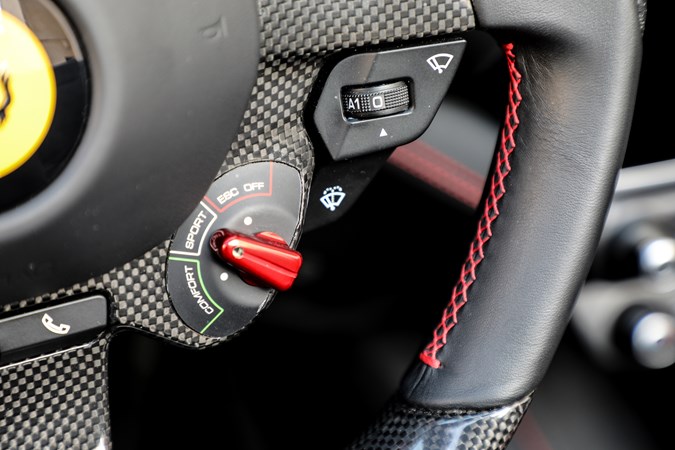
- Moves game on from California T
- Lighter weight for nimble handling
- Excellent brakes and suspension
And so to another of the Portofino’s, and Ferrari’s, talents. The way the Portofino handles is very impressive – even more so considering it has the folding hard-top to take into consideration. Normally a convertible would demonstrate a slight sensation of wobbliness due to a lack of stiffness in the body and chassis. That’s not an issue here.
The biggest change here compared with its California T predecessor – apart from an 80kg weight reduction thanks to the redesigned chassis and body – is a move to electrically assisted power steering. But despite what purists may say, it isn’t to the detriment of driver enjoyment.
It’s quick, razor-sharp and almost perfectly weighted for low-speed driving. Parking is easy, and city centres pose no extra work, making it easy to use every day.
But to unlock the true potential of the Portofino you need to drive quicker, at which point you’ll notice an uncanny handling character that allows the driver a stupendous amount of confidence in the car. You can place it on the entrance to a bend with micron accuracy, and it never feels like you’re asking too much of the front tyres.
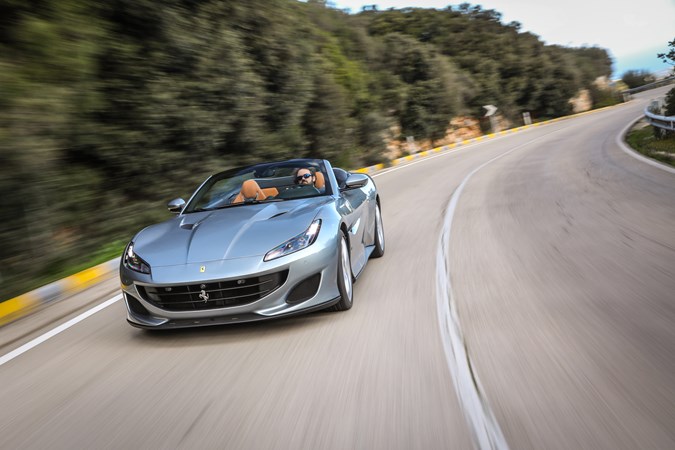
The way it changes direction is equally enthralling, the body reacting obediently to any amount of steering input without feeling heavy or like it’s lumbering about – even in Comfort mode it’s responsive, but for the true Ferrari experience you need to switch the Manettino on the steering wheel to Sport.
We found the standard-fit carbon-ceramic brakes to be incredibly impressive too. They have more pedal feel than a lot of higher-performance offerings from rival companies and no matter how much we leant on them, they delivered predictable and consistent stopping power every single time.
Ferrari Portofino electronic chassis assistance
As a powerful rear-wheel drive car the Portofino impresses with its flexibility in everyday use, and much of that is down to the firm’s E-Diff3, which can electronically simulate the effect of a limited-slip differential to ensure traction is optimised in all conditions.
Plant your foot to the floor a little too early in a corner and you’ll feel this working to liven up the rear end, but don’t fret: the highly sophisticated F1-Trac traction control keeps things in check to prevent a wayward skid.
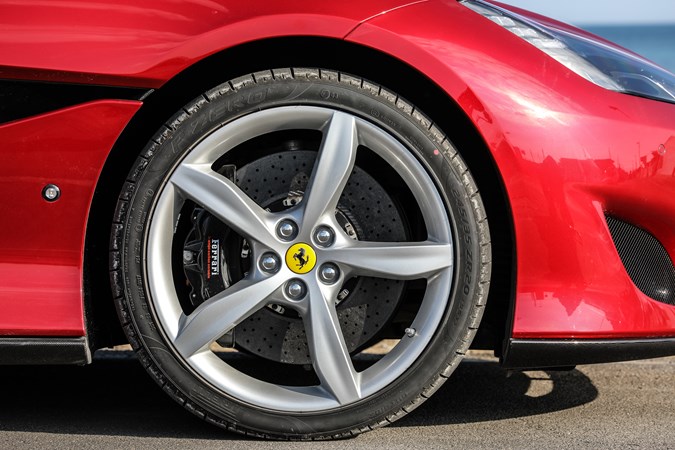
Another feature is the latest iteration of Ferrari’s magnetic Magnaride adaptive suspension, which is optional but is installed on almost all Portofinos sold in the UK. This features stiffer springs but also a wider gap between Sport and Comfort (also controlled via the Manettino mentioned above), making for an even more Jekyll-and-Hyde nature.
The Manettino switch features a third mode that disables the electronic safety net of stability and traction control, but this isn’t meant for road use and is best left alone. Sport is more than enough for most of the people this car will appeal to.
Handling great in all weather
We did notice a difference between the Portofino’s handling depending on whether the roof was up or down, with the former being very slightly more composed over undulating surfaces. We’re only talking tiny margins here, though, and the trade-off is that the cabin feels a touch more cramped – especially with a dark-coloured roofliner.
Our only other slight criticism was the brakes squeaking fairly loudly when cold – easily remedied with a firm push of the pedal, though.



